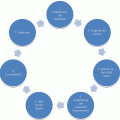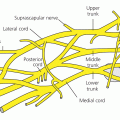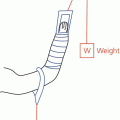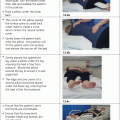Chapter 1
An introduction to orthopaedic and trauma care
Julie Santy-Tomlinson1 and Sonya Clarke2
1 University of Hull, Hull, UK
2 Queen’s University Belfast, Belfast, UK
Introduction
The aim of this chapter is to provide an introduction to orthopaedic and trauma nursing and the care of the orthopaedic and musculoskeletal trauma patient. The focus is on the diversity of the individuals in need of that care and the culture, settings, theory and contexts in which that care takes place. Orthopaedic and trauma nursing is a discrete but diverse specialty focused on the care of the patient with musculoskeletal problems. These problems are related to either disease or injury of the bones, joints, muscle and soft tissues which are central to human movement. Orthopaedic and trauma practitioners must develop knowledge and skills in order to provide expert specialist care based on diverse, highly specific and specialised patient needs. One of the defining features of orthopaedic care is that it is provided across the life span from birth through to death and in every care setting.
Historical perspectives
In an early textbook, Mary Powell (1951) wrote of the general principles of orthopaedic nursing, which embodied the principles of rest balanced with movement and exercise, treatment of the patient as a whole, optimum positioning for joints using splinting and traction, relief of pain and the provision of the best conditions for recovery and healing. This encompassed pre-operative and post-surgical care, trauma care and rehabilitation. With a focus on the nurse–patient relationship and team work, many parallels can be drawn with orthopaedic and trauma nursing today. The book was based on her many experiences up to that time of inter- and post-war orthopaedic care and what she had learnt from the teachings of Dame Agnes Hunt. Although care must have been provided to patients with musculoskeletal conditions and injuries in earlier times, it is often said that orthopaedic nursing’s history – particularly in the UK – began with Dame Agnes Hunt in Shropshire, England in the early decades of the 20th century. Widely associated with the early development of orthopaedic nursing, Agnes Hunt took an approach to the care of individuals with musculoskeletal problems and disability that focused on the importance of rest, fresh air and good nutrition in ensuring the proper development and recovery of diseased, injured and deformed bone, joints and soft tissue. Many common musculoskeletal diseases of that time such as tuberculosis and poliomyelitis were largely eradicated in developed countries during the twentieth century and this has resulted in important and far reaching change in the priorities for orthopaedic and trauma care since that time. Even so, this history remains pertinent to the way in which care is provided today.
The early literature relating to musculoskeletal care focused on the practice of many weeks and months of enforced rest, while the current focus is on early mobilisation and avoiding inactivity. Although much is very different in the second decade of the 21st century, there are some principles of early 20th century care that remain relevant – in particular the need for what Mary Powell (1951) would have called an ‘orthopaedic conscience’ (which she later renamed the ‘orthopaedic eye’) – a special ‘sense’ or consciousness of how movement, position, posture and comfort is central to both the assessment and care of the orthopaedic patient in modern health care. This is largely based on the practitioner’s experience of working with patients. This is reflected in the way in which skilled and experienced orthopaedic and trauma practitioners are able, for example, to recognise nursing needs by instinctively observing the way in which people move or hold themselves. Skilled orthopaedic practitioners, for example, understand how gentle and minimal repositioning of a limb or supporting it with a pillow can improve comfort and support healing and recovery. Such observation and subsequent intervention still demonstrate how nurses make judgments about the needs of patients and formulate decisions about care based on clinical information derived from a variety of sources including, but not exclusively, evidence (Thompson and Dowding 2002).
As a specific entity, orthopaedic nursing has parallels with the development of orthopaedic and trauma surgery and famous surgeons such as Hugh Owen Thomas and Robert Jones. Their efforts led to the inception of orthopaedic surgery in the 1940s as part of the development of the National Health Service (NHS) in the United Kingdom as well as the development of orthopaedic and trauma services around the world. Even so, orthopaedic care has been provided for as long as the musculoskeletal system has been prone to disease and injury, although this previously took place under the auspices of bone setters, barber surgeons and other ‘informal’ carers. Trauma nursing is most often evident in nursing stories from war such as those surrounding the Crimean War and the role played by both Florence Nightingale and Mary Seacole. The care of patients sustaining musculoskeletal trauma has often made strides forward during times of conflict, war, great societal change and disaster whilst the development of elective surgery has been driven by a desire to improve lives by, for example, ameliorating the pain and disability of osteoarthritis and other chronic conditions.
At the beginning of the 20th century a number of specialist orthopaedic hospitals sprang up in the UK. This led to the rapid creation of a network of centres, often in rural or suburban locations, focused on the specialist care of patients and the education of practitioners in the principles and specifics of musculoskeletal care. These organisations also became early developers of the evidence base for orthopaedic care. As services have become more centralised, a number of these hospitals have closed and been integrated into acute urban hospital centres. Those remaining specialist hospitals continue to develop the specialist knowledge for musculoskeletal care alongside emergency departments and acute, outpatient and community units.
As the 20th century progressed musculoskeletal care began to evolve into two related entities – those of elective care and of musculoskeletal trauma care. Elective orthopaedic surgery involves procedures that are planned in advance and are designed to treat or manage known conditions which are causing pain and/or disability. This often includes surgery for arthropathies such as osteo- and rheumatoid arthritis and might also involve surgery to further manage the effects of trauma once initial recovery and healing has taken place. This might include surgery to correct deformity or the removal of ‘metal work.’ Patients with arthropathies such as rheumatoid arthritis are often cared for in specialist centres where the focus is on medical management and rehabilitation rather than on surgery. These patients might, however, be referred for elective surgery when this is thought to be of potential benefit.
Trauma care, on the other hand, is unplanned and involves the management, care and rehabilitation of patients who have suffered injury following a specific event such as a fall, road traffic accident, sporting injury or other mechanism of injury. All structures in the human body are prone to injury and trauma care, therefore, takes place in a variety of settings including the emergency department, intensive care unit and neurosurgical setting as well as the orthopaedic trauma unit. Orthopaedic trauma care is focused specifically on trauma to the musculoskeletal system whilst taking into account the need to include other aspects of trauma management as necessary. The focus in this book is specifically, therefore, on those aspects of trauma care which involve the musculoskeletal system. Often orthopaedic nurses are specialists in one or the other of elective or trauma orthopaedics but many have skills in both areas.
The nature of orthopaedic and musculoskeletal trauma nursing
The orthopaedic practitioner has a unique role, with associated skills and knowledge. Nursing theory applied to orthopaedic and musculoskeletal trauma nursing comes both from general sources relating to nursing and healthcare as a whole, and from specialist sources. The theory which underpins practice is often based on an in-depth knowledge of anatomy and physiology of the musculoskeletal system and of those physical and psychosocial factors which affect musculoskeletal health and well-being and recovery from injury and surgery.
The nature of orthopaedic nursing and associated practice has been a matter of some discussion over many years. Work has focused on its status as a discrete specialty and the specific nursing actions which make it distinct from other nursing specialisms and from ‘generic’ nursing. This has highlighted the importance of specialist skills and the need for specific education for orthopaedic and trauma nursing. One example of this is the assessment skills needed to recognise a very specific set of potential complications of orthopaedic surgery, conditions and injuries (see Chapter 9 for further detail) that are not part of the generic skills required of nurses and other practitioners. See Box 1.1 for further detail of the present state of inquiry into the specialist nature of orthopaedic nursing.
Mobility and function
The focus on the musculoskeletal system and its function in facilitating movement and mobility is an inherent aspect of orthopaedic care. Mobility, movement and function are concepts, therefore, which have long been argued to be central to orthopaedic nursing (Davis 1994, Love 1995, Balcombe et al., 1991). Even so, the concept of mobility itself has been difficult to define and work which considered this is described in more detail in an evidence summary in Box 1.2, in which Ouellet and Rush (1992, 1996, 1998) and Rush and Ouellet (1998) have begun to highlight the complex and essential nature of mobility and its link with immobility as well as the care needs these present. Davis (1994) also emphasised the centrality of mobility for patients with musculoskeletal problems within the physical, psychological and social domains of care. Key to this discussion is an acknowledgement that movement is an essential aspect of human health and wellbeing. It also acknowledges that both musculoskeletal problems and the resulting nursing interventions can lead to immobility and that such immobility or restricted mobility leads to consequences which include serious complications.
Box 1.2 Evidence digest: Mobility as a concept for orthopaedic care
The centrality of mobility in orthopaedic and trauma nursing practice has led to one proposed model for orthopaedic nursing (Balcombe et al., 1991, Davis 1994) which holds mobility at its core. Even so, orthopaedic nursing has tended to continue to use generic nursing models applied to the care of the adult or child. Nursing models ideally aim to illustrate the theory of nursing practice to enable the practitioner to organise and prioritise effective and safe patient care. The ‘nursing process,’ developed by Orlando (1961), provides a logical, structured approach that directs the practitioner’s critical thinking in a dynamic manner. It encourages the nurse to balance scientific evidence, personal interpretation and judgement when delivering patient/family-centred care. This is supported by models of nursing and philosophies of care that help to define the care role and guide practice (Corkin et al., 2012). The nursing process presents as a four stage procedure to: assess (often extended to ‘nursing diagnosis’), plan, implement and evaluate care. Nursing diagnosis involves a professional judgement based on holistic assessment. Figure 1.1 not only identifies the four components, but reinforces its cyclical nature. A variety of models and frameworks have been developed on the basis of the nursing process to plan care.
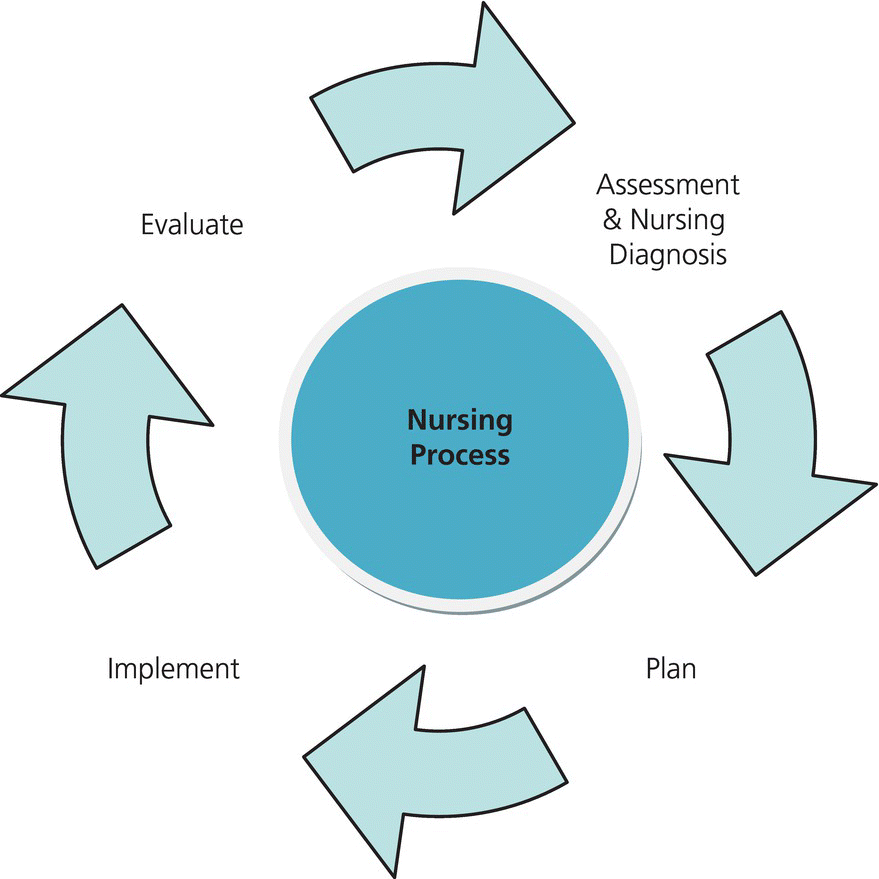
Figure 1.1 The nursing process
Influential work by Fawcett (1995) encouraged many nursing models to incorporate four key components:
- the person
- their environment
- health
- nursing.
Commonly adopted nursing models in orthopaedic and trauma care settings include the Roper, Logan and Tierney’s (2000) model of nursing care (particularly in use in the UK, originally published in 1980, and subsequently revised) based upon activities of living, Orem’s self-care model (2001) and Roy’s Adaptation model (1984). Such models of care have value for the orthopaedic and trauma patient as a way of ensuring that care is provided within a philosophy that ensures that specific individual needs are met. A joint approach is sometimes adopted, especially when planning care for children; for example by combining Casey’s partnership model (1988) and Roper, Logan and Tierney’s (2000) model of care. The first is the founding model of family-centred care and the latter encompasses the 12 activities of daily living and life continuum along with consideration of dependence/ independence. In combination they produce a comprehensive approach to planning of care. Recently, nursing models have been overshadowed by a focus on evidence-based practice, but they continue to play an important part in providing a holistic theoretical foundation for nursing that has the potential to enhance practice (McCrae 2012) within orthopaedic and trauma care. Even so, orthopaedic and trauma nursing perhaps has yet to embrace nursing models fully.
Public health and musculoskeletal conditions and injury
Public health focuses on the health and wellbeing of individuals from a societal perspective. It is synonymous with the prevention of disease and ill health through public action. The public health agenda applied to orthopaedic and trauma care is complex. It is mainly focused on skeletal health but this, in itself, is a multi-faceted issue and necessarily involves consideration of numerous factors which affect musculoskeletal health such as:
- bone development in the child and young adult
- bone health – including, specifically, vitamin D deficiency, osteoporosis, rickets and osteomalacia
- exercise and musculoskeletal fitness
- diet, nutrition and obesity
- life style factors and risk taking behaviours
- accidental injury and its prevention – e.g. road traffic, work place and sports injuries
- ageing.
Musculoskeletal conditions and injuries can affect any member of society and there are few personal, social and cultural boundaries. Human anatomy evolves slowly, but injury can be a result of immediate changes in the weather and other natural conditions as well as societal variations such as diverse and migrating cultures amongst countries. This is apparent, for example, in the reported increase in tuberculosis in immigrant communities in part due to the migration of Asian families (WHO 2012) to other parts of the world. Other issues include changes in population dynamics with an increasingly ageing population leading to an upsurge in fragility fractures. For the adolescent and young adult there is a heightened rate of injury due to ‘risk taking’ behaviour. The epidemiology of orthopaedic-related conditions alters as the pathophysiology of disease processes and the treatment options continue to evolve as a result of emerging technology, research evidence and the ongoing drive for safe, cost-effective care.
Recent renewed concerns about vitamin D deficiency illustrate the changing nature of the public health agenda and musculoskeletal care. Deficiency is associated with rickets, fractures and musculoskeletal symptoms and studies suggest a worrying link with deformity and generalised bone and muscle pain (Judd 2013). Such deficiency is attributed to an increasingly multiethnic population, poor diet and lifestyle choices made by families. Previously a condition linked with poverty, the recent recurrence of rickets in the UK, for example, is linked to changes in the lifestyle of children which has resulted in them spending less time playing out of doors, reducing their exposure to the sunlight that is important for vitamin D and calcium synthesis.
The diverse orthopaedic patient
The vast age range of the orthopaedic trauma patient means that there are a number of conditions and injuries which are more common in different age groups. Age groups carry different risk factors for musculoskeletal problems; these are outlined in Table 1.1. Changes occur as the musculoskeletal system develops, grows and deteriorates and as humans age. Many orthopaedic conditions and fracture trauma injuries are related to changing musculoskeletal structure. Normal and abnormal changes occur in utero, at birth, childhood, adulthood and from old age to death. Intrinsic factors affecting this include abnormal musculoskeletal development such as developmental dysplasia of the hip (DDH), scoliosis and osteogenseis imperfecta with which there are considerable variations in treatment and outcome. Other conditions are often age-related such as osteoporosis and osteoarthritis which are associated with intrinsic factors such as increasing age. Such variations can hopefully be reduced as a result of national guidance and globally relevant initiatives such as those published by the World Health Organization (WHO). Extrinsic factors include the risk-taking of the young person/adolescent leading road traffic trauma alongside accidental and non-accidental injury in vulnerable children and adults. In spite of political and economic development in most parts of the world, social status and environmental conditions continue to impact on musculoskeletal health problems due to issues such as low income and poor education leading to poor diet.
Table 1.1 Age groups In relation to orthopaedic problems
| Age group | Examples often specific to age group |
| Familial/hereditary | Paget’s Osteogenesis imperfecta |
| Congenital | DDH Talipes |
| Post natal and pre-walking | Birth injuries |
| Early childhood | Rickets and osteomalacia Non-accidental injury Accidental injury |
| Mid to late childhood | Juvenile chronic arthritis Perthes’ disease |
| Young person/adolescence | Slipped upper femoral epiphysis Osgood-Schlatter disease |
| Early adulthood | Injuries resulting from high energy trauma Sports injuries Rheumatoid arthritis Ankylosing spondylitis |
| Middle and late adulthood | Work related injury Back pain |
| Later life/older age | Injuries resulting from low energy trauma Fragility fractures Osteoporosis Degenerative joint conditions |
The care journey in different settings
In many of the chapters in this book we see that the care journey takes place against a background of changing health services and political priorities as well as individual needs. There is no reason to believe that the enormous change and development of health care services seen in the later decades of the 20th century and at the beginning of the 21st century are likely to slow down in developed and developing countries. The practitioner, therefore, needs to ensure they have a dynamic understanding of how this affects the care of the orthopaedic and trauma patient, especially in relation to the setting in which care takes place.
Ambulatory care is increasingly providing opportunities for patients to be offered treatment and care without a stay in hospital or, at most, a very short stay. This is driven by the need to reduce the costs of healthcare as well as an acknowledgement that an acute hospital is not always the best place for the patient to be. In the orthopaedic and trauma setting this is seen as feasible where the impact on the patient’s ability to carry out fundamental activities is minor. It is important to bear in mind, however, that non-admission to or early discharge from hospital can be both anxiety provoking and uncomfortable for patients and their families and there is a need to provide support that ensures that specialist orthopaedic advice and services are accessible remotely from the hospital. In particular, services need to ensure that patients recovering at a distance from an acute hospital setting in their own homes are afforded support and a care package which includes fundamental elements such as effective pain relief, good nutrition, support for rehabilitation, access to advice and support and all of those things the patient needs to reach both their recovery and rehabilitation potential as well as maintain their safety. Such services can be complex and difficult to coordinate. One of the difficulties in providing adequate support in the patient’s home can be funding and purchasing mismatches between the acute hospital and community services, which may be quite separate entities depending on the structure and funding of the health care system. Family support for care in the home is also becoming increasingly challenging as the role and employment of family members change.
For more than a quarter of a century there has been a strong focus on reducing lengths of stay and moving from hospital-based to community-based care. This focus is driven by the need to stretch limited resources while maintaining the quality of care. While this shift has long been an important aim for health care managers and policy makers, the reality has been more problematic and this change is taking place slowly. Musculoskeletal conditions, injuries and surgery are problems which take time to resolve and may leave the individual of any age with varying degrees of temporary or permanent disability which require careful support and rehabilitation. Within this drive is a danger that patients are being discharged from hospital with residual nursing needs and there is a consequent need to develop care practice at the boundaries of the care settings. The development of technology is offering new opportunities for monitoring and supporting patients in their homes, especially in rural and remote settings, but in many areas this has yet to be applied to the orthopaedic patient. Meanwhile orthopaedic and trauma practitioners need to develop skills in providing care and support from a distance and the use of communication technology is likely to increase as this aim becomes more relevant in the future.
Ethical and legal aspects of orthopaedic and trauma care
Practitioners are increasingly required to consider the complex nature of ethical issues which affect the orthopaedic and trauma patient. As with all other branches of nursing, there are both specialised and general issues that affect the specific patient group and the orthopaedic practitioner needs a deep working understanding of these.
Much of the discussion about ethical issues in all aspects of nursing is related to the nature and quality of care. Nursing care is often seen as being synonymous with holistic patient-centred approaches which are non-judgmental and include the demonstration of attitudes and behaviours that are sensitive to the needs of patients and carers and respect individuality and choice (McSherry et al., 2012). This is especially important when orthopaedic and trauma care takes place in highly pressurised environments in which it is possible to lose sight of patient-centred priorities. Effective education of orthopaedic practitioners, insightful and transformational leadership and the development of a strong patient priority-centred evidence base are central to this. Within this is the need to develop practitioners not only with the right knowledge, skills and attitudes but with a passion for working with patients with very specific and significant needs related to their musculoskeletal problem.
The provision of quality care within a framework which values and respects dignity is a constant source of discussion in all health care settings. This is particularly important in maintaining their own safety when the patient is a vulnerable child or older adult or other individual with impairment. As people with learning disabilities live longer they are more likely to require care in orthopaedic settings. Mental health problems such as debilitating depression frequently affect care and recovery. There remains a need for the practitioner to develop the skills to care for orthopaedic patients with a wide variety of needs which make them vulnerable. The ‘safeguarding’ from harm of both children and vulnerable adults is becoming an increasing priority and must be central to all care provided.
In any health care setting, informed consent to all procedures and activities is an important part of care along with consideration of the mental capacity of the patient. Orthopaedic interventions carry with them significant risks. Understanding how to assess the capacity of an individual to make decisions about their care is an important part of informed consent – as is the ability to ensure that patients, carers and families understand the risks of the decisions they are being asked to make. Practitioners must adhere to Acts of Parliament in their own country which provide a statutory framework to empower and protect people of all ages who may lack capacity to make their own decisions.
There is a danger that orthopaedic practitioners assume that ‘do not resuscitate’ orders and ‘living wills’ do not relate to the orthopaedic/trauma patient group except in the oncology setting. This can perhaps be traced to the specialty’s focus on ‘healing and recovery.’ However, as caring develops in the coming decades it is likely that there will be a greater focus on end of life issues and practitioners must be aware of national guidance and legislation that requires them to be aware of best practice in both decision making and communication. One example of this is in the discussion regarding the need to consider palliative care for frail older patients with major orthopaedic injuries. Research increasingly shows that some conditions are life-limiting. One example is hip fracture which often occurs in very frail elderly patients and may need to instigate a sensitive discussion about the need to implement end of life care (Murray et al., 2012). Decisions and discussions about such matters may not have been, but will need to be, part of the orthopaedic practitioners’ skills set as the quality of end of life care reaches a more prominent place in all settings.
Summary
This chapter has examined the nature of orthopaedic and trauma nursing and the main issues which drive its development including public health, political, practical and legal and ethical agendas. It has highlighted the diverse needs of the orthopaedic patient along the entire age continuum and in the variety of settings in which care takes place. It acknowledges that modern health care is complicated and has many drivers and that this leads to numerous complex ethical issues with which the practitioner must engage. It is hoped that these principles can be successfully applied to the material contained within the remainder of this book.
Recommended further reading
- Judd, J. (2010) Defining expertise in paediatric orthopaedic nursing. International Journal of Orthopaedic and Trauma Nursing, 14(3), 159–168.
- McSherry, W., McSherry, R. & Watson, R. (2012) Care in Nursing. Principles, Values and Skills. Oxford University Press, Oxford.
- Santy, J. (2001) An investigation of the reality of nursing work with orthopaedic patients. Journal of Orthopaedic Nursing, 5(1), 22–29.
- Sellman, D. (2011) What Makes a Good Nurse? Jessica Kingsley, London.
References
- Balcombe, K. Davis, P. and Lim, E. (1991) A nursing model for orthopaedics. Nursing Standard, 5(49), 26–28.
- Casey, A. (1988) A Partnership With Child and Family. Senior Nurse, 8(4), 8–9.
- Corkin, D., Clarke, S. and Liggett, L. (Eds) (2012) Care Planning in Children and Young People’s Nursing. Wiley-Blackwell, Oxford.
- Davis, P.S. (1994) Nursing the Orthopaedic Patient. Churchill Livingstone, Edinburgh.
- Drozd, M., Jester, R. and Santy, J. (2007) The inherent components of the orthopaedic nursing role: an exploratory study. Journal of Orthopaedic Nursing, 11(1), 43–52.
- Fawcett, J. (1995) Analysis and Evaluation of Conceptual Models of Nursing, 3rd edn. F.A. Davis Company, Philadelphia.
- Judd, J. (2010) Defining expertise in paediatric orthopaedic nursing. International Journal of Orthopaedic and Trauma Nursing, 14(3), 159–168.
- Judd, J. (2013) Rickets in the 21st-century: a review of low vitamin D and its management. International Journal of Orthopaedic and Trauma Nursing, 17(4), 199–208.
- Love, C. (1995) Orthopaedic nursing: a study of its specialty status. Nursing Standard, 9(44), 36–40.
- Ouellet, L.L. and Rush, K.L. (1992) A synthesis of selected literature on mobility: A basis for studying impaired mobility. International Journal of Nursing Knowledge, 3(2), 72–80.
- Ouellet, L.L. and Rush, K.L. (1996) A study of nurses’ perceptions of client mobility. Western Journal of Nursing Research, 18(5), 565–579.
- Ouellet, L.L. and Rush, K.L. (1998) Conceptual Module of Client Mobility. Journal of Orthopaedic Nursing, 2(3), 132–135.
- McCrae, N. (2012) Wither Nursing Models? The value of nursing theory in the context of evidence-based practice and multidisciplinary health care. Journal of Advanced Nursing, 68(1), 222–229.
- McSherry, W., McSherry, R. and Watson, R. (2012) Care in Nursing. Principles, Values and Skills. Oxford University Press, Oxford.
- Murray, I.R., Biant, L.C., Clement, N.C. and Murray, S.A. (2012) Should a hip fracture in a frail older person be a trigger for assessment of palliative care needs? Supportive and Palliative Care, 1(1), 3–4.
- Orem, D.E. (2001) Nursing: Concepts of Practice, 6th edn. Mosby, London.
- Orlando, I.J. (1961) The Dynamic Nurse-patient Relationship: Function, Process and Principles. G.P. Putnam’s Sons, New York.
- Powell, M. (1951) Orthopaedic Nursing. E. & S. Livingstone, Edinburgh.
- Roper, N., Logan, W.W. and Tierney, A.J. (2000) The Roper-Logan-Tierney Model of Nursing: Based on Activities of Living. Elsevier Health Sciences, Edinburgh.
- Roy, C. (1984) Introduction to Nursing: An Adaptation Model, 2nd edn. Prentice Hall, Englewood Cliffs, NJ.
- Rush, K.L. and Ouellet, L.L. (1998) An analysis of elderly clients’ views of mobility. Western Journal of Nursing Research, 20(3), 295–311.
- Santy, J. (2001) An investigation of the reality of nursing work with orthopaedic patients. Journal of Orthopaedic Nursing, 5(1), 22–29.
- Thompson, C. Dowding, D. (Eds) (2002) Clinical Decision Making and Judgement in Nursing. Churchill Livingstone, Edinburgh.
- World Health Organization (WHO) (2012) Global Tuberculosis Report 2012: Executive Summary. Available at: http://www.who.int/tb/publications/global_report/en/ (accessed: 14 April 2013).


